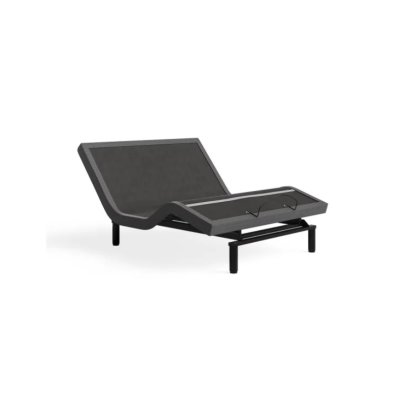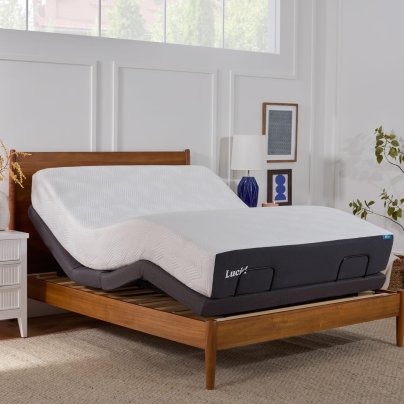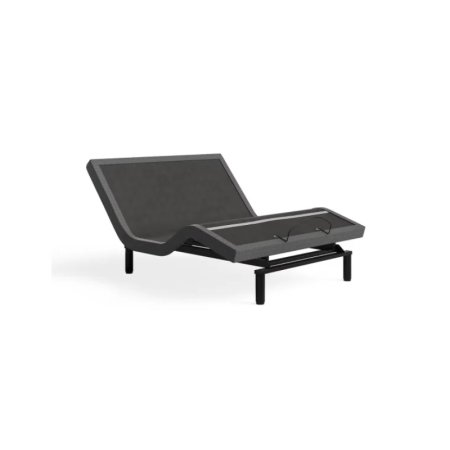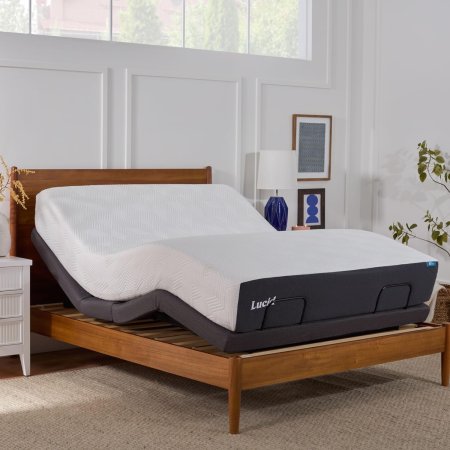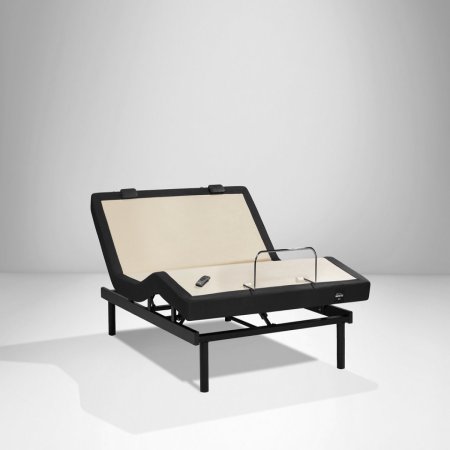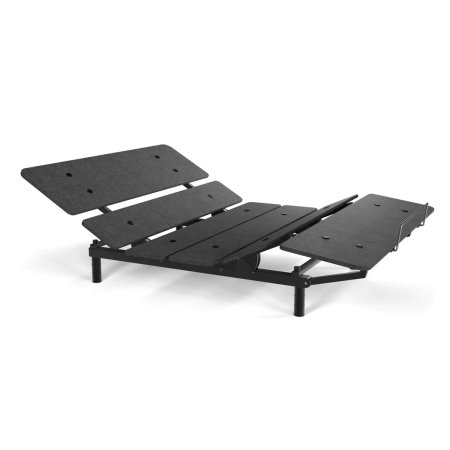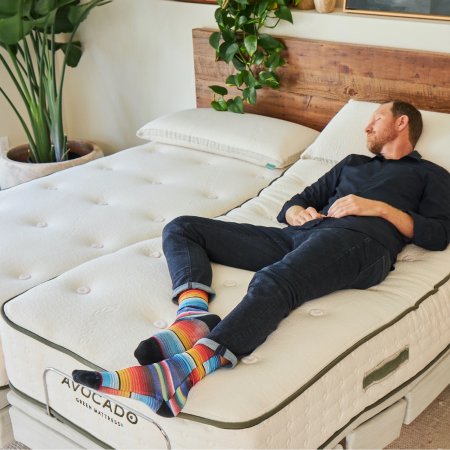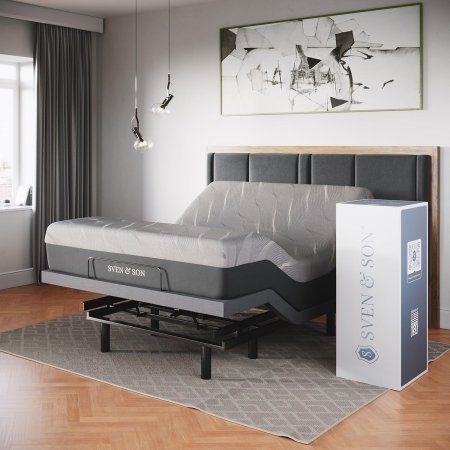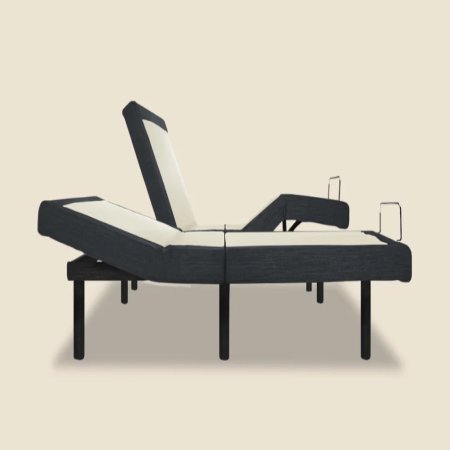
We may earn revenue from the products available on this page and participate in affiliate programs. Learn More ›
Adjustable bed frames make it possible to change the position of your bed at the touch of a button. Whether you’re after additional health benefits or just more comfort, this adjustability is a nice feature to have in a space where you (hopefully) spend around a third of your day. Similar to a good regular bed frame, the best adjustable beds are supportive and sturdy. Their adjustability can help with comfort as well as offer relief from back pain, acid reflux, and snoring, so they’re a worthwhile investment for many. We researched over 20 different models to determine which are the best adjustable bed frames on the market.
- BEST OVERALL: Saatva Adjustable Base Plus
- BEST BANG FOR THE BUCK: Lucid L300 Adjustable Bed Frame
- BEST CUSTOMIZABLE: Purple Premium Plus Smart Base
- BEST SLEEP TRACKING: Tempur-Pedic Ergo Smart Base
- BEST EASY ASSEMBLY: Winkbed Adjustable Winkbase 2.0
- BEST ECO-FRIENDLY: Avocado Eco Pro Adjustable Base
- BEST INCLINE RANGE: Sven & Son Classic Adjustable Bed Base
- BEST TRIAL PERIOD: Puffy Serenity Adjustable Base
- ALSO CONSIDER: GhostBed Adjustable Base

How We Chose the Best Adjustable Bed Frames
A bed frame is never a small purchase—it’s one of the most important pieces of furniture in the bedroom, supporting your mattress to ensure a good night’s sleep. An adjustable bed frame doesn’t only have to be comfortable and look nice; it also has to be reliable, with dependable and fairly quiet moving parts.
We highlighted bed frames made of high-quality materials from reputable brands. To find the standout picks, we researched over 20 highly rated bed frames, also checking third-party and shopper reviews to ensure the bed frames lived up to their promises. The adjustable bed frames on our list are supportive and have various adjustable features. We spoke to Derek Hales, founder and editor-in-chief of NapLab.com, who recommended beds with a zero-gravity position: “In this sleeping position, there is significantly less weight and pressure on the lower back. For many sleepers, this sleeping position can dramatically reduce body pains and aches.”
Hales highlights another big perk: “The second major benefit is that the zero-gravity sleeping position helps to keep your airway open. For those who snore or otherwise have trouble breathing during the night, it can improve airflow and allow you to stay asleep longer and deeper.” To take advantage of these benefits, all of the bed frames on our list have adjustable head and foot settings, and most feature a zero-gravity preset so that you don’t need to manually adjust the bed each time.
Aesthetics matter, too, so the frames on our list look great. Most of them feature simple, contemporary designs to suit most rooms. Many are compatible with headboards and decorative bed frames. We also prioritized beds with additional features, and most of the picks on our list have useful extras like position presets, massage features, or USB charging ports.
Our Top Picks
An adjustable bed frame can make a bedroom feel like more of a cozy oasis. Maximize comfort for both relaxation and sleep with one of these adjustable bed frames.
Best Overall
Saatva Adjustable Base Plus
Pros
- Offered in a wide range of sizes; options available to suit almost any bedroom
- Useful presets as well as the option for users to set their own favorite presets
- Excellent massage options with independent and adjustable head, body, and leg massage features
- Includes some lighting features: ambient underbed lighting and built-in flashlight in the wireless remote
Cons
- Saatva does not permit returns or exchanges on this product
Product Specs
- Size options: Twin, twin XL, full, queen, king, split king, California king, split California king, upper-flex queen, and upper-flex king
- Presets: Zero-gravity, anti-snore, head-up, flat, and customizable presets
- Massaging: Yes
The Saatva Adjustable Base Plus feels luxurious, offering a host of appealing features for those looking for an incredibly comfortable adjustable bed. As expected, users can adjust the angle of the head and feet. Not sure of the perfect position? This base comes with a few presets: zero-gravity, anti-snore, head-up, and flat, and users can customize their own presets, too. These settings are all controlled from the wireless remote, which has a built-in flashlight for safety at night. This base also has cozy underbed lighting that users can switch on via the remote.
The “wall-hugging design” fixes the bed in an optimal position, maintaining its distance from the wall and nearby nightstands even when big adjustments are made. For extra comfort, the base also has massaging features, with head, full-body, and foot and leg massage functions. It’s available in a wide range of sizes, ranging from twin to California king. Additional sizes like split king, split California king, upper-flex queen, and upper-flex king are available as well. The latter two are compatible with Saatva’s upper-flex mattresses, which allow users to independently adjust the head incline of each side of the bed.
Get the Saatva adjustable bed frame at Saatva.
Best Bang For The Buck
Lucid L300 Adjustable Bed Frame
Pros
- Users can create their own split-king frame by combining 2 twin XL bases
- Easy to set up: requires 2 people and about 5 minutes
- Includes 2 USB charging ports on each side to charge devices
- Lucid offers a 100-day sleep trial when purchased directly from the brand
Cons
- Lacks some comfort features of other adjustable beds; does not have massage or zero-gravity functions
- Size options are limited; no king-size frame
Product Specs
- Size options: Twin XL, full, and queen
- Presets: Customizable and flat presets
- Massaging: No
An adjustable bed frame may seem like a luxury product, but it doesn’t have to come at an excessively high price. Lucid’s L300 adjustable bed frame is an economical option for shoppers on a budget. In this case, its lower cost does mean limited features; for example, it doesn’t have a massage function. It’s also only offered in a twin XL, full, or queen size (though two twin XL frames can be combined to create a split-king bed). However, despite these limitations, we think it’s a value-packed option.
The remote lets users choose from a couple of preset bed positions (a customizable memory position and a flat preset), but these do not include a zero-gravity setting. One perk of this bed is the inclusion of dual USB charging ports on each side. It’s easy to set up, too, taking just a few minutes when installed by two people. For those hoping to try out an adjustable bed frame for the first time, this is an excellent pick. Not only is it budget-friendly, but unlike many other adjustable bases, it also comes with a 100-day sleep trial when purchased directly from the brand.
Get the Lucid adjustable bed frame at Amazon, Walmart, or Lucid.
Best Customizable
Purple Premium Plus Smart Base
Pros
- Several customizable features, including head, feet, pillow, and lumbar support tilt
- Adjustable bed frame support legs can be adjusted from 3 inches to 12 inches tall
- Can be controlled using the Purple Smart Base app from compatible smart devices
Cons
- Purple does not offer returns or exchanges on this bed base
Product Specs
- Size options: Twin XL, queen, king, California king, and split king
- Presets: Zero-gravity, anti-snore, customizable, and flat presets
- Massaging: Yes
With a range of customizable features, the Purple Premium Plus Smart Base is an excellent choice for shoppers who want a versatile, upgraded bed. Apart from manual head and foot adjustment (which is standard on all our top picks), this bed also has a pillow tilt feature and lumbar support adjustment.
The pillow tilt adjustment helps fine-tune pillow placement, adding an extra joint at the head of the bed where the bed can flex. The adjustable lumbar support allows users to dial in the exact degree of lumbar support the bed offers.
This bed has multiple massage settings, as well as flat, zero-gravity, and anti-snore presets. All of these features can be controlled using the included remote or the Purple Smart Base app on a compatible smart device. Beyond its comfort settings, this base also includes adjustable height legs. It comes with four 3-inch segments for a maximum height of 12 inches.
Get the Purple adjustable bed frame at Purple or Ashley Furniture.
Best Sleep-Tracking
Tempur-Pedic Ergo Smart Base
Pros
- Includes automatic sleep-tracking features to provide personalized sleep insights and tips (available through a smartphone app)
- Snore response feature automatically adjusts bed to an anti-snore position when it detects snoring
- Also comes with excellent adjustable base features, including zero-gravity preset and adjustable lumbar support
Cons
- Tempur-Pedic does not accept returns on this product
- Having pets in the bed can interfere with sleep-tracking functions
Product Specs
- Size options: Twin XL, full, queen, king, split king, California king, and split California king
- Presets: Zero-gravity, anti-snore, customizable, and flat presets
- Massaging: Yes
Smart sleep tech and adjustable comfort come together in Tempur-Pedic’s Ergo Smart Base. Not only is the base adjustable, but it also has an integrated sleep-tracking system as well. Using Sleeptracker-AI technology, this bed frame monitors sleeping activity to help provide sleep insights, all available through the smartphone app. The app can provide sleeping tips based on recorded insights, and the bed itself has a snore response feature, adjusting its position slightly when it detects snoring.
Users can control the bed with the included remote, smartphone app, or using voice controls through Alexa. Aside from the smart features, the adjustable base allows users to adjust the head, foot, and lumbar support. It has zero-gravity, anti-snoring, and customizable presets, as well as a dual-zone massage function and USB charging ports.
Get the Tempur-Pedic adjustable bed frame at The Home Depot, Ashley Furniture, or Tempur-Pedic.
Best Easy Assembly
Winkbed Adjustable Winkbase 2.0
Pros
- Bed is easier to assemble than most due to no-tool setup and clever panel design
- Ships in a relatively small package; easy assembly and disassembly is helpful for frequent movers
- Includes a child-lock function, free-fall design, and emergency lowering feature to improve safety
Cons
- Lacks massaging functions
- Winkbed does not offer returns or exchanges on this product
Product Specs
- Size options: Twin XL, queen, king, and California king
- Presets: Zero-gravity, anti-snore, lounge, and flat presets
- Massaging: No
First-time buyers of an adjustable bed might feel intimidated by the setup process. Most adjustable beds are designed to be easy for a couple of people to set up, but the Winkbed Adjustable Winkbase 2.0 makes the process easier than ever.
Rather than being comprised of one or two large panels, this bed base is made up of six panels, which arrive in a small package that looks more like a shelving package than a bed frame. No tools are required for setup. This also makes the bed easy to disassemble and move about for renters and other frequent movers.
Though it has a less traditional design, this adjustable bed still has features typical of the best adjustable bed frames. It is manually adjustable and has a few preset settings, including zero-gravity, anti-snore, lounge, and flat positions. All are controllable through the one-touch wireless remote. With safety in mind, this bed base also has a child lock, a free-fall design, and an emergency lowering feature.
Get the Winkbed adjustable bed frame at Winkbed.
Best Eco-Friendly
Avocado Eco Pro Adjustable Base
Pros
- Avocado prioritizes sustainability—a Climate Neutral Certified company that uses natural materials
- Includes an upholstered bed frame made from Global Organic Textile Standard (GOTS)–certified organic cotton and wool and real wood legs
- Silent motors ensure that the bed adjusts quietly, which is good for light sleepers
Cons
- Avocado does not offer returns on this product
- This bed base is on the expensive side
Product Specs
- Size options: Twin XL, queen, split king, and split California king
- Presets: Zero-gravity, anti-snore, customizable, and flat presets
- Massaging: Yes
Avocado aims to create beds that are better for the environment, and this adjustable base is no exception. To start, the brand is a Climate Neutral Certified company, which means it reduces and offsets its emissions. The adjustable part of this bed frame is metal (like most on the market), but the frame is also upholstered—it’s the only one on this list that includes a decorative frame. The upholstery is made using GOTS-certified organic cotton. Wooden legs support the frame, and shoppers can also add an optional headboard.
On top of being made of long-lasting and earth-friendly materials, this adjustable base bed frame is comfortable and quiet. It features two silent motors, so it isn’t prone to whirring adjustment sounds like some other bed bases. A massage function and edge-to-edge lumbar support add comfort, and users can choose from customizable adjustments or included presets (which include zero gravity and anti-snore). Devices can plug into the dual USB ports on each side of the bed.
Get the Avocado adjustable bed frame at Avocado.
Best Incline Range
Sven & Son Classic Adjustable Bed Base
Pros
- Impressive adjustment range: head lifts up to 75 degrees to place users in a seated position
- Includes abundant features like presets, underbed lighting, several massage modes, and USB charging ports
- Bed base and mattress bundles are available at a discounted price
Cons
- Size options are rather limited; no full-size adjustable bed frames offered
Product Specs
- Size options: Twin XL, queen, king, and split king
- Presets: Zero-gravity, anti-snore, customizable, and flat presets
- Massaging: Yes
Many adjustable bed bases don’t share their exact incline angle—and many shoppers also won’t care too much. But for those who do almost everything from bed (including working or studying), it might be important to sit completely upright. In that case, the Sven & Son Classic adjustable bed base is a good choice. The top of the bed lifts up to 75 degrees and the foot to 45 degrees, offering plenty of adjustment options to get comfortable.
Like many of the other top adjustable bed frames on our list, it also has zero-gravity, anti-snore, and customizable presets. Built-in USB ports and underbed lighting add even more convenience, and for extra comfort, this bed base has massage features as well. All of this is controlled using the wireless remote, which also has a built-in flashlight.
Get the Sven & Son adjustable bed frame at Amazon or Sven & Son.
Best Trial Period
Puffy Serenity Adjustable Base
Pros
- Puffy offers a 101-night sleep trial, which includes free returns for unsatisfied customers
- Comes with a universal headboard mount so that users can add a headboard of their choosing
- Dual massage zones allow users to independently control massage settings
Cons
- Is not available in regular king or California king sizes
Product Specs
- Size options: Twin XL, full, queen, or split king
- Presets: Zero-gravity, customizable, and flat presets
- Massaging: Yes
Most adjustable bed frames are final sale and don’t come with a trial period, even from major mattress brands that offer at-home mattress trials. That’s not the case with the Puffy Serenity adjustable base—the brand offers a 101-night sleep trial, complete with free shipping and free returns.
There’s a lot to love about this adjustable metal bed frame, though, so there’s good reason to keep it. It has dual massage zones and USB charging ports. Get into a zero-gravity position with a click of the remote preset. At night, switch on the underbed lighting for pleasant ambient lighting. This bed base is built for customization, too. It has a universal headboard attachment, so it will work with most headboards.
Get the Puffy adjustable bed frame at Puffy.
Also Consider
GhostBed Adjustable Base
Pros
- Lots of preset options for easy operation, including zero-gravity, TV, lounge, and a self-set preset
- 4 USB ports for device charging (2 on each side)
- No tools are required for setup, and the base comes with adjustable-height legs
Cons
- GhostBed does not offer a sleep trial on this bed base
- Limited size options; lacks full, king, and California king sizes
Product Specs
- Size options: Twin XL, queen, and split king
- Presets: Zero-gravity, TV, anti-snore, lounge, customizable, and flat presets
- Massaging: Yes
The GhostBed adjustable base is a great choice for those who prefer using presets rather than tinkering with manual settings. This adjustable base has several presets, including zero-gravity, anti-snore, TV, lounge, flat, and one customizable preset. Users can also adjust the bed manually using the included remote.
Like many others on this list, this base also has a massage feature with independent head and foot massage settings. Four USB ports (two on each side) offer the option to charge multiple devices. Underbed lights can help illuminate the bedroom with a pleasant glow and prevent stubbed toes. The toolless setup makes this base relatively easy to assemble, and users can adjust its height up to 12 inches with the three-piece legs.
Get the GhostBed adjustable bed frame at Amazon, The Home Depot, or GhostBed.
Jump to Our Top Picks
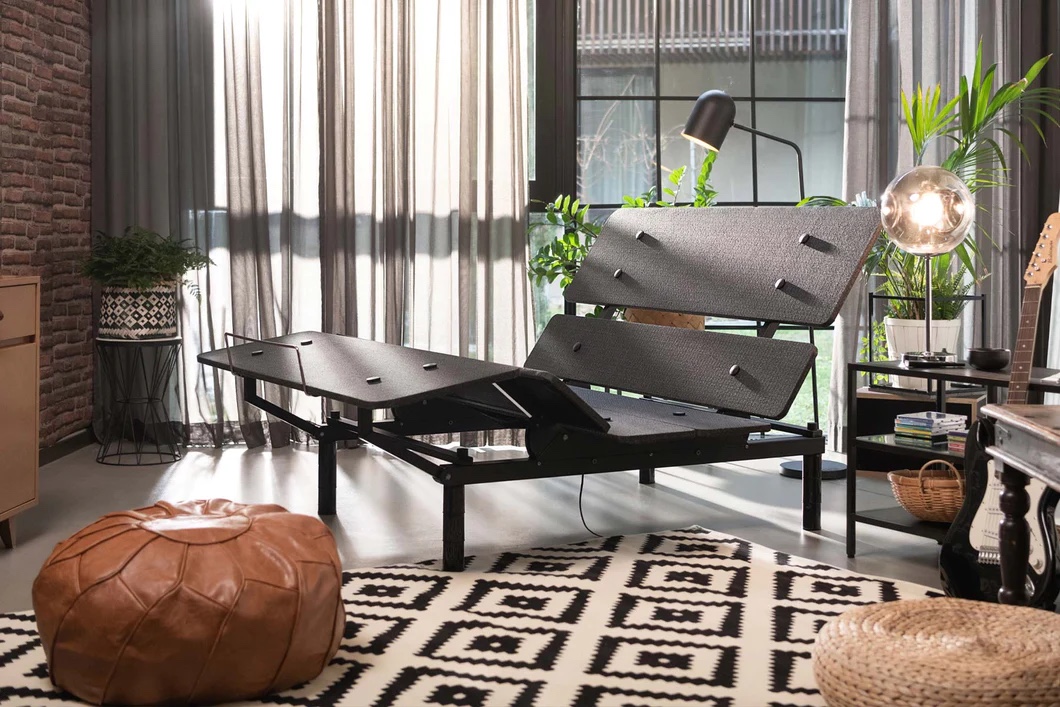
What to Consider When Choosing an Adjustable Bed Frame
There’s a lot to consider when shopping for an adjustable bed frame—even more than you’d need to consider when shopping for a regular bed frame. Besides the frame being sturdy, supportive, and attractive-looking, you will also want to consider the bed size and mattress compatibility, ease of assembly, bed positions, and additional features.
Size and Mattress Compatibility
Just like regular bed frames, electric adjustable bed frame bases come in standard sizes, including twin, full, queen, king, and California king. Unique to adjustable bed frames are the split-king and split California king sizes, which are essentially a king bed or California king split in half, with independently adjustable sides. This is a great choice for those who sleep with a partner who might prefer different bed settings.
Many contemporary mattresses can be used with adjustable bed frames. The only real necessity is that they’re flexible enough to move with the adjustable bed frame. This eliminates most traditional innerspring mattresses, which are too stiff to flex. Some hybrid mattresses are possible to use with adjustable bed frames; consult the mattress manufacturer if you’re unsure. Split bases require a split mattress (often, two twin XL mattresses can work), which allows each side of a dual adjustable bed frame to move independently.
Assembly
It might feel intimidating to assemble an adjustable bed frame due to its electronic components. Luckily, most options are pretty straightforward to put together. Like other bed frames that are shipped to your door, adjustable versions are designed to be easy to install. The top options come with consumer-friendly directions intended for a two-person installation process. Most of these bed bases can also be paired with an adjustable bed frame headboard or bed frame.
If you don’t want to bother with the assembly process, some companies offer white glove delivery that includes assembly. Keep in mind that this type of service is usually only available when ordering directly from the manufacturer (rather than a big box retailer).
Positions
Most adjustable bed frames have the option to raise the head or the foot of the bed using an included remote control. You can raise the head of the bed to set your upper body in a comfortable position for reading or watching TV. A raised bed head can also help with snoring or acid reflux, and some adjustable bed frames even have a snoring setting that adjusts the bed to an optimal angle to prevent snoring. You can also adjust the settings to elevate the lower body, which may improve circulation, reduce swelling in the feet, and relieve some types of back pain.
Some beds have a zero-gravity position, which is supposed to put less pressure on the muscles and spine (simulating weightlessness by trying to put an even amount of pressure across the whole body). This can help some people with aches and pains, and some users note it helps them sleep better, too.
Some noise is unavoidable when these bed frames adjust between positions. If this type of noise will disturb you, opt for a quieter model. Check reviews to get an idea of an adjustable frame’s noise level.
Additional Features
If a plain adjustable bed doesn’t provide everything you’re looking for, seek out one with additional features that can make the bed even more comfortable or useful. All adjustable beds have manual controls to modify the head or foot of the bed. Many also have presets that automatically shift the bed into a set position (for example, a sitting position, an anti-snoring position, or a zero-gravity position). A few have self-set presets, which means the bed can remember your favorite positions. In small rooms, look for wall-hugging bed bases, which keep the mattress as close to its original spot as possible. That way, adjusting the bed won’t take you too far away from your nightstand.
Some adjustable beds come with massage features to promote relaxation; usually, this is a vibrating massage function. Look for options with a timer if you want to fall asleep with the massage on. And though it’s not the best for sleep hygiene, many people go to bed with their phones, so some adjustable bed frames have built-in USB charging ports for topping up devices.
FAQs
Wondering if an adjustable bed frame is right for you? We’ve answered some frequently asked questions ahead.
Q. Are adjustable beds worth it?
If you see yourself taking advantage of its features, then yes, an adjustable bed is often worth it. Being able to raise the head or foot of the bed isn’t just useful; for some users, it can help with some health issues (for example, providing relief from acid reflux). A few cheap adjustable bed frames are also available for those on a budget.
Q. How long do adjustable bed frames last?
Expect a high-quality adjustable bed frame to last as long as a good regular bed frame: upwards of a decade.
Q. What’s the best way to keep sheets on an adjustable bed?
Sheets can slip off of adjustable beds as you move the bed about. Fitted sheet fasteners, like the Gorilla Grip Bed Sheet Straps, can help keep sheets on an adjustable bed.
Q. Can I use a regular mattress on an adjustable bed?
Many regular mattresses can be used on an adjustable bed. The exception is most innerspring mattresses, which aren’t flexible enough to move with the bed base. Foam, latex, and many hybrid mattresses will work with most adjustable bed frames.
